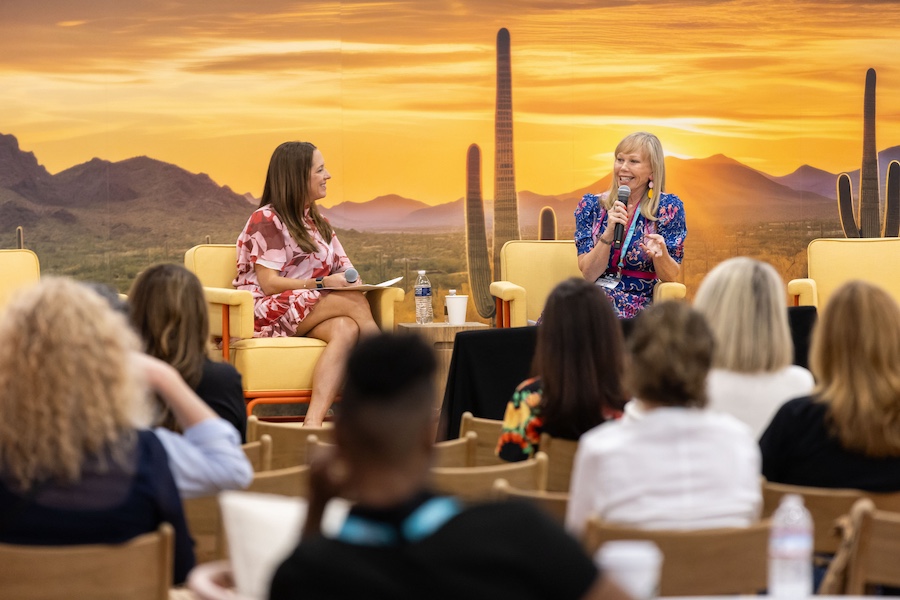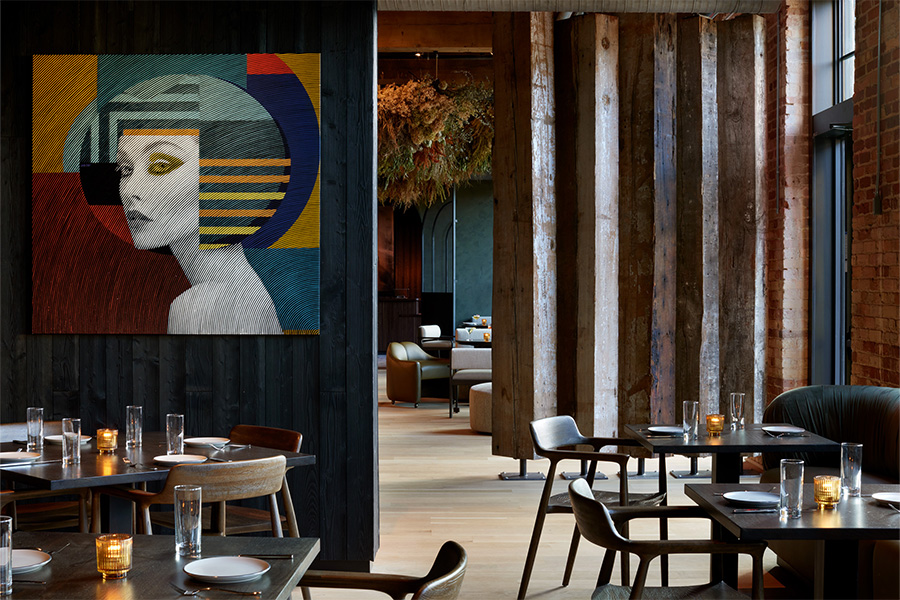This year’s HD Expo + Conference keynote lineup brought together a powerhouse group of visionaries who have made a lasting impact on hospitality design and continue forging the way into the future.
From Todd Avery Lenahan’s reimagining of luxury and Kit Kemp’s vibrant, joy-filled interiors to AvroKO’s collaborative approach, each speaker offered a distinct, personal perspective on what it means to craft meaningful guest experiences. Sam Nazarian delved into the convergence of lifestyle, food, wellness, and entertainment, while Chad Oppenheim shared his pioneering projects and explored how architecture can elevate the human experience.
Together, their insights reinforced that hospitality today is as much about emotion and storytelling as it is about business and strategy.
Todd-Avery Lenahan: Luxury rooted in story and soul
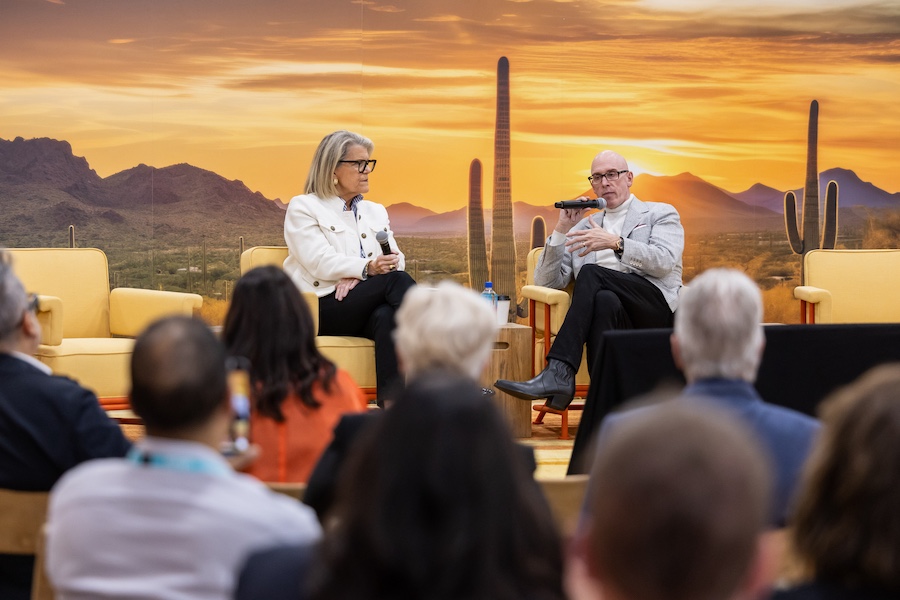
Margaret McMahon, global practice principal of Wimberly Interiorsm and Todd-Avery Lenahan, president and chief creative officer of Wynn Design and Development
Todd-Avery Lenahan, president and chief creative officer of Wynn Design and Development, offered a nuanced perspective on luxury hospitality design, emphasizing that “I never start thinking initially about the physical manifestation of the ultimate experience—I think about what the emotional and experiential tenor of the place is.”
For Lenahan, people come before products, and the focus is on crafting experiences that stem from a deep understanding of what individuals find meaningful. He likens his approach to writing sheet music or a script, where spaces and architectural elements become characters in a narrative. This storytelling approach, he says, requires trust. “You’ve got to grant me artistic trust because without that, I’m nowhere,” he says.
Lenahan also challenged the notion that luxury must be tied to affluence. “You do not have to be born with a silver spoon,” he says. “There are so many things I do that reference entirely different archetypes that find their way into hotels, whether it’s museums, theaters, galleries, retail, educational institutions, parks—be astute of the world because luxury is not just material. Go to the incredible gardens of the world that are free to the public and soak up the high concept, textures, materials, and perspectives.”
As for advice to the next generation, Lenahan emphasized the importance of drawing by hand. While acknowledging technology’s growing presence, he cautions: “AI absolves [young designers] from the responsibility and rigor of drawing… if you do not draw, you don’t know the fundamentals of drafting. You have to draw, draw, draw. There has to be that mind, hand, eye connection.”
AvroKO: The power of creative partnership

Shoemaker Rauen with AvroKO founders William Harris, Kristina O’Neal, Adam Farmerie, and Greg Bradshaw
The four founders of AvroKO—Kristina O’Neal, William Harris, Greg Bradshaw, and Adam Farmerie—shared an intimate look at their two-decade journey, one rooted in creativity, occasional tension, and an unwavering collaborative spirit. More than business acumen, it’s the strength of their partnership that has fueled the firm’s longevity.
A key component of that bond is their annual summit, which O’Neal describes as “almost like marriage counseling,” where, she says, “we can be honest and say, ‘I hate this. I love this. I’m afraid of this. This hurt my feelings. This is amazing.’” She adds: “Part of the adventure has been trying things on and supporting each other through the good and the bad, and also supporting our staff when they have a longing that they want to go do. Everybody’s in it.”
Their approach to growth remains organic and deeply human-centered. “The biggest lesson learned was the value of the decided commitment that we all gave each other,” says Harris. “That’s trickled down into a lot of our client relations, our staff relations, our restaurants, and our other businesses.”
O’Neal echoes the sentiment: “The greatest lesson learned is the nourishment of being indefatigable and being able to say, no matter what, the trust is there—even if things aren’t going right, we’re here, we’re going to do it together and go forward.”
Kit Kemp: Living life in bold color
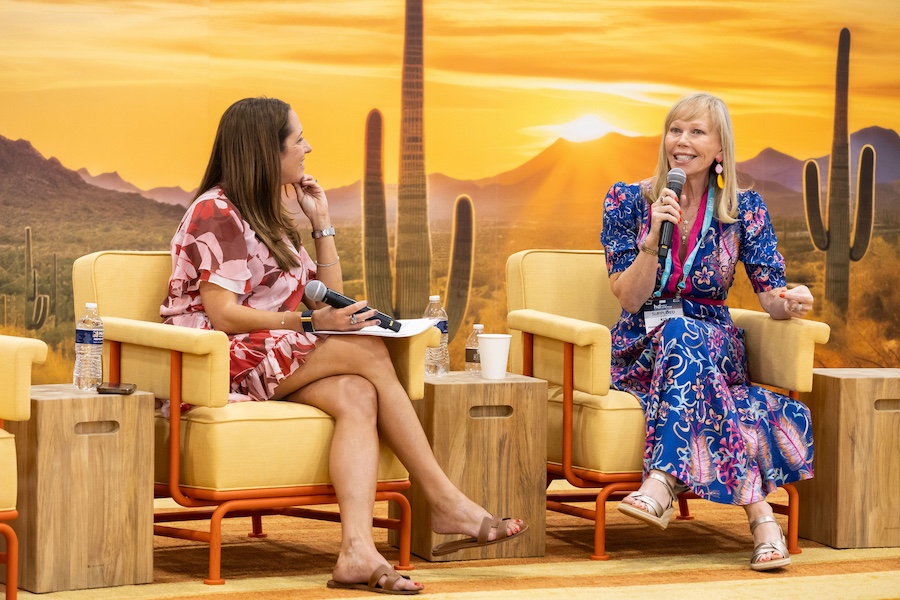
Shoemaker Rauen and Kemp
Firmdale Hotels founder and creative director Kit Kemp brought her distinct penchant for color and playfulness to the stage. Her work is instantly recognizable yet never repetitive. “I’m terrified of beige,” she joked, championing instead an approach where each hotel tells its own story through bold colors, textures, and patterns.
Each property is crafted with layered colors, textures, and collaborations with emerging artists and craftspeople, creating “a handwriting that you’re always staying in a Firmdale hotel, but each one is individual.” She emphasized the idea of making hospitality an adventure, “because that’s what it’s all about—capturing the imagination for travelers.”
Reflecting on Firmdale’s genesis, Kemp recalls opening Dorset Square Hotel with her husband Tim in 1985. “When you are young, you are very arrogant and we never took no for an answer.” The transformation of the hotel epitomized this ethos, defying an early naysayer who said, “you will never cook a meal in this kitchen,” when they showed them the hotel’s basement kitchen.
Kemp’s advice is unequivocal: “Everybody’s going to tell you you can’t do it. You’ve got to dust yourself down, pick yourself up, and just keep on going.”
Sam Nazarian: Building for what’s next
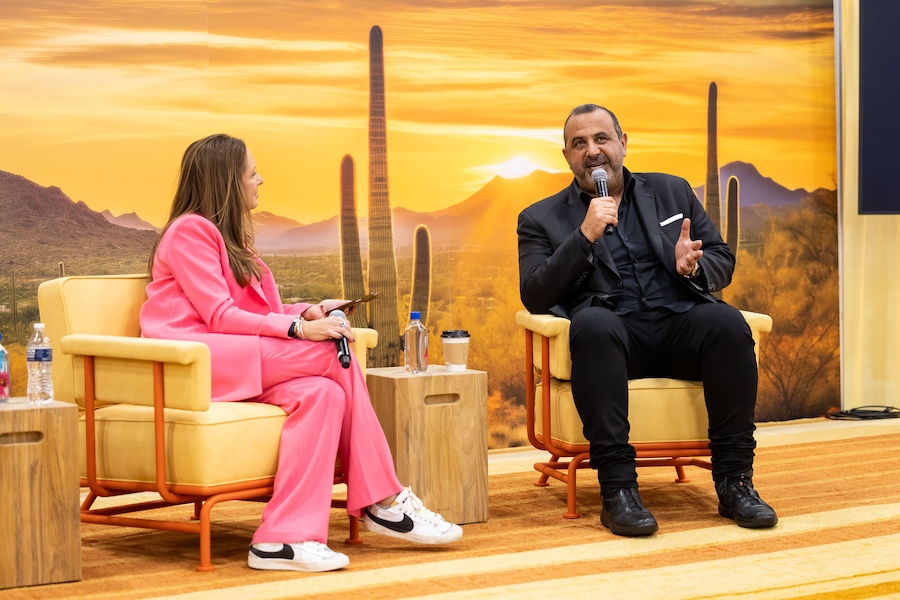
Shoemaker Rauen and Sam Nazarian, founder and CEO of sbe
For Sam Nazarian, hospitality has always been deeply personal. “I built these brands for myself, really,” the sbe founder and CEO shared during his keynote. Reflecting on his early days in the industry, Nazarian recalled identifying a missing link in the guest experience—namely, the lack of integration between design, food, and entertainment—and transforming that insight into a full-service lifestyle empire.
His breakthrough came with the launch of SLS. “Our premise was always ‘not your father’s Four Seasons’—how can we deliver style, luxury, and service all under one roof?” That meant bringing in visionaries like Philippe Starck, pioneering fully integrated hotels establishing a strong “connection with the mission of the brand,” he shares. “I build the brands first and then I find locations.”
Today, Nazarian is once again reimagining the future of hospitality through two ventures: HQ and Estate Hotels & Residences. HQ, created in partnership with Wyndham, is a smart hospitality concept that speaks to next-gen travelers, while the Estate, a collaboration with Tony Robbins, is a longevity-focused luxury brand that merges hospitality with wellness and medical science. “We built the Estate knowing that this category is going to evolve fast,” he says.
Nazarian credits his instinct, relentless drive, and immigrant roots for his continued success. “I had a lot of confidence but also a self-consciousness that never went away, which [pushes me] to innovate, disrupt, and expand. It’s sheer will.”
Chad Oppenheim: The force of architecture
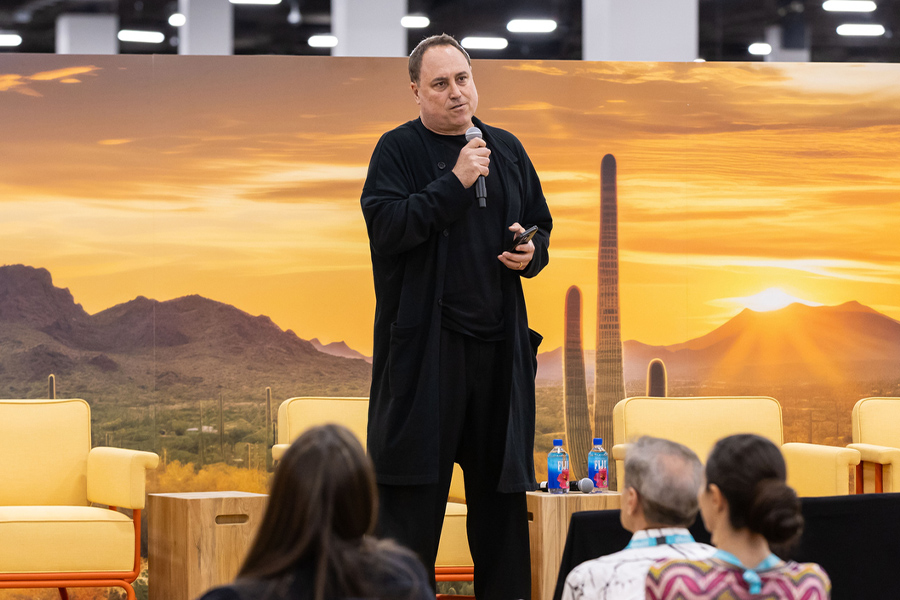
Oppenheim Architecture founder Chad Oppenheim
Architect Chad Oppenheim traces the evolution of his creative ethos, from childhood dreams shaped by pop culture and movies to global projects rooted in sustainability, sensory immersion, and emotional connection. Oppenheim’s work is driven by the desire to reconnect people—with themselves, with each other, and with nature.
“Even though we’re the most connected species, we’ve become the most disconnected.” His response is to design for emotion and immersion. “We’re not designing for what things look like, we’re designing for what they feel like.” His approach avoids imposing form, instead he’s “trying to find what the design wants to be and let it flow through me.”
Today, Oppenheim’s studio spans six continents and multiple typologies, yet a core mission runs through his work: “Everything I do is about making the world more pleasurable for people.” This is evident in projects like Harbour Island house in the Bahamas, where “we let [the trees] grow through the architecture,” and aimed to make it feel like it’s been always been there.
In Utah, he built a circular Six Senses resort to view the passage of time, removing style in favor of timeless form. In Costa Rica, he designed a resort around the trees that existed with minimal intervention, using local lava stone. A recurring theme is adapting design to setting—like the Langham Hotel in Australia, modeled on scanned crystals: “I try to find something. Nature has so many beautiful things in it.” Perhaps most emblematic is his work in Saudi Arabia’s Wadi Rum desert, where he designed a resort carved into the rock, using only local sand and minerals.
Ultimately, Oppenheim invited his audience to reconsider architecture as a force of quiet transformation: “It’s about how we can help [create] that connection to the place.”

